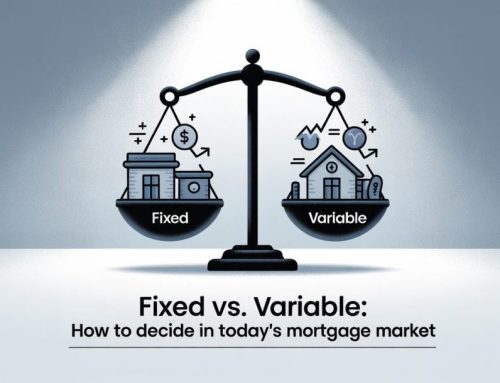With expectations set for a significant decrease in mortgage rates over the next few years, the majority of mortgage seekers have been choosing shorter term fixed rate products. However, shorter term rates come at a premium. The shorter the term, the higher the rate.
Your essentially accepting pricier, higher rate mortgage with the anticipation of offsetting the additional cost with a much lower rate at the time of renewal. Essentially, it’s a calculated gamble–enduring a bit of financial discomfort now with the expectation of a more rewarding outcome later. It’s short-term pain for long term gain.
As 3-year fixed mortgage rates are seen as having the perfect combination of shorter term and lower rate, they have become the go-to choice for the vast majority over the past year.
But with the anticipated rate cuts ‘potentially’ right around the corner, is a 3-year fixed mortgage still the best choice?
Choosing the Ideal Mortgage Term
Deciding on the perfect mortgage term is a highly individualized choice; what suits one might not suit another. The recent and extreme popularity of 3-year fixed terms among borrowers is a due to its appealing balance of a comparatively lower rate combined with a shorter commitment period.
There are currently 3-year fixed rates as low as 4.84% for an insured mortgage with the lowest 5-year term in the same category being 4.59%. On a $650,000 mortgage, the 0.25% difference works out to $4,954 over the first three years. This means that you’ll be in the hole to the tune of close to $5,000 by the end of the 3-year term.
Your renewal rates will need to be low enough to not just offset the $5K, but to come out ahead with a larger difference for the remaining two years (to match the 5-year comparison term). After all, we’re not just in this to break even.
The break-even rate is 4.14%. This means that after three years, the 2-year fixed rate would need to be lower than this to come out ahead with the higher, shorter-term rate. If the 2-year fixed rate at renewal is marginally lower, then you come out just marginally head. If it’s a lot lower, then you’ll come out ahead by a much larger margin.
The big question is… where do you think rates will be in a few years?
What the Big Six Banks are Expecting
The forecasts from the big six show the Bank of Canada to cutting their rate anywhere from 0.75% to 1.25% by the end of 2024, followed by another 1.00% to 1.75% by the end of 2025. That’s a total of 1.75% to 3.00% over the next 21 months, or the equivalent of seven to twelve 0.25% cuts. But just as we saw oversized rate hikes in 2022, oversized rate cuts are expected. It comes down to how quickly the Bank of Canada feels it will need to move to kickstart the economy.
The cuts will begin by the end of the second quarter, according to four of the six of the big banks. The next rate announcement is scheduled for April 10th where I would not expect a change. It’s the following and final announcement set for June 10th that everyone will be watching closely. If the cut happens to come in the 2nd quarter, then this is the date we can expect it on.
The remaining two banks, Scotia and National, are expecting the cuts to begin in the 3rd quarter. At the beginning of the year, all six thought the cuts would start in Q2. Forecasts are always changing. I personally would not be surprised the forecasts from all the banks change yet again, pushing the cuts out to the third quarter. We’ll see.
1 and 2 Year Fixed Rates
There are some considering even shorter terms such as 1 or 2-year fixed rate products. After all, if rates are supposed to fall this much over the next year, then why not go with a 1-year term to maximize the savings? The problem is that there is a significant rate premium attached to 1-year fixed mortgage rates. It can be as much as 2% or even greater which is significant.
I discussed this option in detail in my recent blog: Is a 1 Year Fixed Mortgage Worth the Price?’
2 year fixed rates also carry a significant premium, with the lowest rates being in the 5.89% to 6.09% range. Given that the cuts have been pushed out as much as they have, most people are still a bit too cautious to pull the trigger, leaving the 3-year fixed as the best choice.
The Variable Rate Mortgage Gamble
In most markets, variable rate mortgages are priced lower than the fixed rate options. But that is not the case today, with variable rates also carrying a significant rate premium over 3-5 year fixed terms. It’s quite uncommon for variable rates to be higher, let alone this much higher. In today’s market, you can expect to pay a premium of 0.75% to 1.25% over the lowest 3-year fixed rates, depending on your situation.
The larger difference between fixed and variable, the deeper the financial hole you dig for yourself. The longer it takes for rates to drop, the deeper the hole and the more time it will take to dig yourself out of it.
If the anticipated rate cuts unfold on schedule and align with current forecasts, choosing a variable rate mortgage could end up being financially beneficial. But given the prevailing uncertainty and poor track record of variable rate products over the past couple of years has, few people have the appetite for the risk.
In time, as the market’s direction becomes clearer and predictions more certain, variable rate mortgages will regain their popularity. But for now, most are choosing to play it safe, watching and waiting until the moment feels right. But we’re just not quite there yet.
I discussed this topic in detail in my recent blog: Are Variable Rates Now Worth Considering?
Conclusion
3 year fixed rates have the right combination of lower rate and shorter term, which still makes them the most attractive option for the majority. Yes, the 3-year term will cost a bit more over the term, however, they should save more in the long run assuming that the rates are in fact substantially lower at the end of three years.
As I say in my book, there is no one size fits all mortgage advice and what’s right for one person may not be right for the next. It’s not about what your brother, sister, parents, friends, work associates, your neighbor or anyone else says you should do. It’s not likely that they’re mortgage experts, and having been through the process several times certainly does not make them one. Yet, everyone still seems to think they’re an expert. While they may mean well, they can only come from their own perspectives. Their own tolerance for risk and their own financial situation. Everyone’s situation can be a bit different.
This is why you need to do what you think is right for you. Not what’s right for someone else. It’s your money and your mortgage. As always, my team and I will do our best to advise you as if you were our own family and will help you to determine the exact mortgage product suited to your particular needs. We’re never more than a phone call or email away.
As for what we can expect from rates?
All we can do is go by the forecasts mixed in with our expertise and guidance. No one can predict the outcome and all we can do is speculate. Time will tell and anything can happen.
New 3rd Edition of Beat the Bank Now Available!
For a plethora of more great information and how to position yourself for maximum savings over the life of your mortgage, be sure to pick up a copy of the brand-new 3rd edition of my Amazon #1 best-selling book Beat the Bank – How to Win the Mortgage Game in Canada. It was just released on March 10th, 2024. It starts with the basics and moves into the more complex money saving strategies. If you read the previous editions, the new 3rd edition was completely rewritten, with an additional 200+ pages of new content and three new chapters. The 3rd edition of Beat the Bank is truly the ultimate resource to position yourself for maximum savings on your mortgage over time. Get your copy today!








Leave A Comment